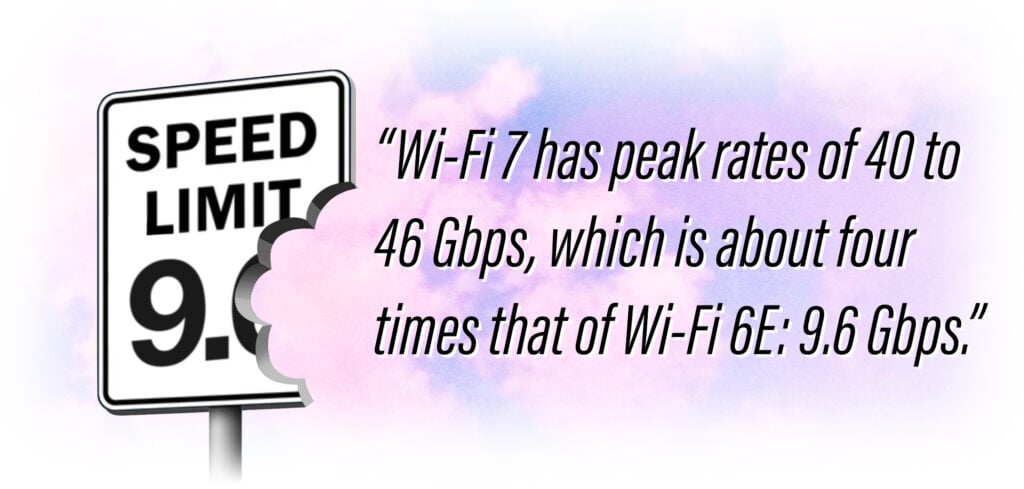
Wi-Fi 7 is getting close to widespread availability.
The 802.11be standard is considered essentially done and is expected to be ratified in September 2024, per IEEE 802.11, The Working Group Setting the Standards for Wireless LANs (802.11be). The Wi-Fi Alliance also released its certification program in January. The standard is not expected to change at this point.
This blog examines the following questions:
• What are the benefits of Wi-Fi 7?
• What are the other high-level factors to consider concerning whether to shift to Wi-Fi 7?
The Status of Wi-Fi 7
As with prior new Wi-Fi standards, some vendors have jumped into the market early. Full standard compliance is a purchase consideration, except perhaps for limited or home use. And cross-vendor inter-operability issues, and any under-specified gaps or quirks of the standard may still show up. Hopefully only minor issues but that’s why there is a certification program.
Major networking vendors (“corporate grade Wi-Fi 7”) so far:
End system device support
End system device support is of course also necessary. Apparently, Samsung has cell phone support now for Wi-Fi 7, and other cell phone vendors plan for it by late 2024. Computer support for Wi-Fi 7 may have a similar timeframe.
Why Wi-Fi 7?
The usual driver for new Wi-Fi standards is more speed, and that remains the case with Wi-Fi 7.
| Feature | Wi-Fi 7 | Wi-Fi 6E |
| Peak Rates | 40 to 46 Gbps | 9.6 Gbps |
| Spatial Streams | Supports more spatial streams | Fewer spatial streams |
| Channel Width | Up to 320 MHz | Up to 160 MHz |
Wi-Fi 7 has peak rates of 40 to 46 Gbps, which is about four times that of Wi-Fi 6E: 9.6 Gbps. There is a caveat to that, in that max performance requires wide channels and no competition for bandwidth. So, actual field performance may be lower.
Partly addressing that, Wi-Fi 7 supports more “spatial streams,” allowing an AP to talk to more devices at one time. However, that does require more antennas on the AP, which may cost more.

What this does for a business
• More speed in Wi-Fi 7 potentially opens up new lower latency and data-intensive applications. E.g., some augmented or virtual reality, or more IOT devices. Warehousing, real-time manufacturing, etc.
• Support for more devices or users with low interference accommodates the growing use of Wi-Fi. That includes large office spaces, co-working spaces, sensors, shopper cell phones, etc. Or lots of sensors or other Wi-Fi connected devices.
Note:
As with prior Wi-Fi standards, version 7 is backwards-compatible. In particular, it supports the same three RF bands that version 6E does: 2.4, 5, and 6 GHz bands. Recall that Wi-Fi 6E added 6 GHz to the bands supported by Wi-Fi 6.
Wi-Fi 7 however does add something to the channel scheme, namely Multi-Link Operation (“MLO”). MLO connections can be spread across two or three of the bands. Since devices are competing to use each band, this provides potentially lower latency because a device may be able to send its data sooner on one of the bands, rather than being locked in on just one band. One might think of this as having multiple conversations in progress, providing two or three times the chances to “get a word in edge-wise.”
Interesting Fact:
“My colleague Martijn van Overbeek notes that cellular has had MLO since 2009: WI #460007 (3gpp.org).”
Wi-Fi 7 also allows channels of up to 320 MHz, whereas Wi-Fi 6 only goes to 160 MHz. Wider channels like this allow more data throughput. However, they also tie up more RF spectrum. In an urban high-rise environment, many neighbors may or may not be using such “wide” channels, so “your mileage may vary.”
To understand the impact: for extreme home use, Wi-Fi 6E might support one very high-speed gamer’s networking needs. Wi-Fi 7 might support 4. Or comparable numbers of streaming HD video such as 8K movies, AR/VR gaming, or super-fast file downloads.
Conclusion:
You may want to strictly manage the use of channels and channel width, also MLO.
When Should I Make the Switch to Wi-Fi 7?
The other big business question is this: when do you shift?
Since Wi-Fi 7 is backwards compatible, any replacement or new devices should probably be Wi-Fi 7, preferably certified compatible. Generally, one would expect new / replacement deployments to be Wi-Fi 7. However, one expects prices on Wi-Fi 6 gear to drop once there is solid Wi-Fi 7 gear availability, so if speed is not a big concern, an organization might opt for Wi-Fi 6.
Mixing old and new Wi-Fi devices is not a great idea. Mixed 6E and 7 will limit use of some of the new features in Wi-Fi 7. So, Wi-Fi 7 would optimally align with your Wi-Fi and desktop/other device refresh cycles, with Wi-Fi 7 AP deployment ideally preceding end-user device support. Or, in a couple of years, providing a speed boost?
A Real-World Story
A while ago, I got asked to figure out why users in a hospital lost Wi-Fi connectivity when walking down a certain corridor. It turned out the middle of the corridor was only within range of an AP in an adjacent operating room (OR). Over time, the OR staff brought more personal and medical Wi-Fi devices into the OR. As a result, they maxed out the AP’s capacity. (Cisco AP, setting for max number of users to ensure adequate performance when loaded.)
So “new” roaming users would be denied a connection by the AP, based on its settings.
Takeaway Thought:
Wi-Fi is useful for directly networking devices, but the number of connected users, sensors, and devices keep growing. We all want more of a Good Thing. So, the number of users and volume of data per user or device should be part of Wi-Fi signal strength and coverage planning!
Conclusion
Wi-Fi 7 APs are available or coming later this year. They offer higher performance, initially at likely a premium price. That also applies to the number of spatial streams/antennas for support of more simultaneous RF conversations.
So, it is time to incorporate Wi-Fi 7 into your planning, factoring in related considerations such as laptop or other refresh cycles, user needs as far as speeds, other uses of Wi-Fi in your organization, and cost/benefit. Note that if you’re still on Wi-Fi 6, 5, or earlier, then Wi-Fi 6E is an alternative that might offer sufficient performance boost at a lower price point.
Should you choose to move to Wi-Fi 7, migration planning will be needed. Replacing APs first can make sense, due to backwards compatibility. Some analysis and/or field-testing will be advisable as far as replacement of previous APs in place versus new site survey and/or deployment. The use of existing LAN cabling to attach the AP’s too is handy, but not at the price of performance gaps. (You DID leave extra LAN cabling coiled in the ceiling to allow simple AP repositioning, I hope!)
